Agkistrodon
| Agkistrodon | |
|---|---|

| |
| Eastern copperhead, Agkistrodon contortrix | |
| Scientific classification | |
| Kingdom: | Animalia |
| Phylum: | Chordata |
| Class: | Reptilia |
| Order: | Squamata |
| Suborder: | Serpentes |
| Family: | Viperidae |
| Subfamily: | Crotalinae |
| Genus: | Palisot de Beauvois, 1799 |
| Synonyms | |
Agkistrodon is a genus of pit vipers commonly known as American moccasins.[3][4] The genus is endemic to North America, ranging from the northeastern United States to northern Costa Rica.[2] Eight species are recognized as being valid,[5][6] all of them monotypic and closely related.[7] Common names include: cottonmouths, copperheads, and cantils.[8]
Name origin
The name Agkistrodon comes from the Greek words ankistron (ἄγκιστρον, 'fishhook', with the irregular transliteration gk rather than the usual nk) and odon (ὀδών)[9] 'tooth'[10] and is likely a reference to the fangs.[8]
Some varieties of the genus are given the common name "moccasin" or "moccasin snake" in the United States, which is the Algonquian word for "shoe". The origin of this nickname is unknown. The first known use of "moccasin" to refer to a deadly venomous snake was in a 1765 publication. The nickname is used to refer to both cottonmouths and copperheads. According to the Word Detective, this use may be related to their color and appearance or the silence with which they move.[11] Another source for this name may be the Native American word "mokesoji" of unknown origin and meaning.[12]
Description
.jpg)
Members of the genus Agkistrodon have a number of features in common. All species have a relatively broad head with short fangs. A loreal scale is present, except in A. piscivorus. Usually, nine large symmetrical platelike scales are on the crown of the head, but in all species, these are often irregularly fragmented or have sutures, especially in A. bilineatus. All have a sharply defined canthus rostralis and a vertically elliptical pupil. Usually eight (6–10) supralabial scales and usually 10–11 (8–13) sublabials are present. The dorsal scales are mostly keeled and at midbody number 21–25 (usually 23), while A. piscivorus has 23–27 (usually 25). The snake has 127–157 ventral scales and 36–71 subcaudals. Of the latter, some may be divided. The anal scale is single. All have a color pattern of 10–20 dark crossbands on a lighter ground color, although sometimes the crossbands are staggered as half bands on either side of the body.[8]
The phylogeny of the species has long been controversial. Studies based on morphological[7] and venom characteristics[13] support the idea that A. bilineatus and A. contortrix are more closely related. However, an analysis of mitochondrial DNA,[14] as well as more recent molecular studies,[15][16] have concluded that A. bilineatus and A. piscivorus are sister taxa, with A. contortrix being a sister species to them both.[8]
Geographic range
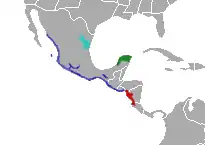
Agkistrodon species are found in North America from the northeastern and central United States southward through peninsular Florida and southwestern Texas, and in Central America on the Atlantic versant from Tamaulipas and Nuevo León southward to the Yucatan Peninsula, Belize, and Guatemala. They are seen along the Pacific coastal plain and lower foothills from Sonora south through Guatemala, El Salvador, Honduras, and Nicaragua to northwestern Costa Rica.[2]
Behavior
All Agkistrodon species are semiaquatic to terrestrial and are often found near sources of water. However, A. contortrix and A. bilineatus are also found in dry habitats, often far from permanent streams or ponds.[8]
Reproduction
The members of the genus Agkistrodon are all ovoviviparous.[8]
A 2012 study found that they are not only capable of parthenogenesis (asexual reproduction), but that litters created without a male may account for up to 5% of litters in the wild, even in areas that have males present. This phenomenon had previously only been observed in captive populations. [2]
Venom
Pit vipers of the genus Agkistrodon rely on a potent venom they produce for their survival. Used to immobilize prey and fend off predators, one bite can inject enough venom into a human to cause severe pain, swelling, weakness, difficulty breathing, hemorrhaging, gangrene, fever, vomiting, and in rare instances, even death.[17]
The venom of all species is assumed to be not unlike that of A. contortrix, which contains thrombin-like enzymes that act upon the coagulant activity of the blood. A study of electrophoretic patterns of proteins in venoms among and within populations of A. contortrix and A. piscivorus showed that substantial variation exists,[13] and no reason exists to believe that these differences do not correspond with variations in toxicity.[8]
Research
In a study conducted at the College of Medicine at the University of Florida, venom from Agkistrodon piscivorous was injected into the lymph fluid of a frog. The frog immediately suffocated because of the collapse of its lung sacs. The venom even resulted in lung constriction when directly applied to the surface of the frog's lungs. To test this, trace amounts of venom were dropped onto a single pulmonary sac in a frog's lung after it was anesthetized and its chest cavity dissected open. A drop of solution containing a venom concentration of 1 mg/ml was enough to cause contraction of the pulmonary artery adventitia after 5–8 sec in a frog weighing 40 g (1.4 oz).[18] The study found, however, that this toxic effect is simply a tool the snake can choose to employ from an accessory venom gland it has. In most instances, the viper injects a venom that tends to immobilize, not kill, its prey before ingestion. In this case, the main venom glands secrete a toxin that inhibits the prey's sympathetic response to flee or fend off its predator. This essentially stuns the animal so that the predator can easily attack.[18]
Species
| Image | Species and author[19] | Common name | Geographic range[2][7][8][20] |
|---|---|---|---|
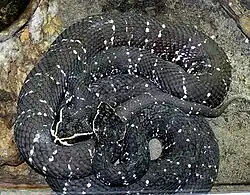
|
A. bilineatus | cantil[4] |
Mexico and Central America, from southern Sonora, Mexico south to Guatemala, El Salvador, and Honduras. |
_-_Flickr_-_2ndPeter_(1).jpg)
|
A. contortrixT | eastern copperhead[3] | The United States (East Texas, Oklahoma, and Kansas, eastward to the Atlantic coast, including Missouri, Arkansas, Louisiana, Mississippi, Alabama, Georgia, northern Florida, South Carolina, North Carolina, Tennessee, Kentucky, Virginia, West Virginia, Illinois, Indiana, Ohio, Iowa, Pennsylvania, Maryland, New Jersey, Delaware, New York, Connecticut, Massachusetts). |
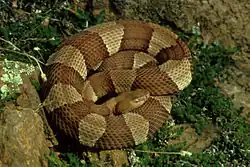
|
A. laticinctus | broad-banded copperhead[3] | Eastern Kansas, central Oklahoma, central and Trans-Pecos Texas, and adjacent areas of northern Chihuahua and Coahuila, Mexico. |
| A. howardgloydi | Gloyd's moccasin[19] | Northwestern Costa Rica, western Nicaragua, southern Honduras. | |
_photographed_in_Liberty_Co.%252C_Texas._W._L._Farr.jpg)
|
A. piscivorus | northern cottonmouth[3] | The eastern United States from extreme southeastern Virginia, south through peninsular Florida and west to Arkansas, southeastern Kansas, eastern and southern Oklahoma and eastern and central Texas. A few records exist from along the Rio Grande in Texas, but these are thought to represent isolated populations that possibly no longer exist. |
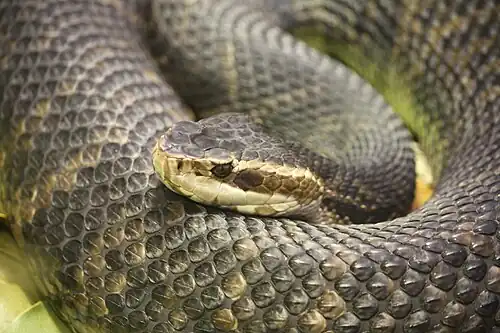
|
A. conanti | Florida cottonmouth[3] | Southernmost Georgia through Florida. |
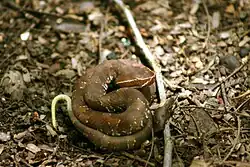
|
A. russeolus | Yucatecan cantil[4] | Yucatan, Mexico, northern Guatemala, northern Belize. |

|
A. taylori | Taylor's cantil[4] | Gulf Coast lowlands of northeast Mexico, primarily southern Tamaulipas, with a few records from adjacent areas of Nuevo Leon, San Luis Potosi, Veracruz, and Hidalgo. |
Taxonomy
This genus was previously much larger and also included the following genera:[2]
- Calloselasma – ground pit viper found in Southeast Asia (Malaya).
- Deinagkistrodon – the hundred-pace viper found mostly in southern China.
- Gloydius – ground pit vipers found in Asia.
- Hypnale – hump-nosed vipers found in India and Sri Lanka.
References
- ^ "†Agkistrodon Huxley 1865 (cottonmouth)". Paleobiology Database. Retrieved 2025-02-11.
- ^ a b c d e f McDiarmid RW, Campbell JA, Touré TA (1999). Snake Species of the World: A Taxonomic and Geographic Reference, Vol. 1. Washington, District of Columbia: Herpetologists' League. 511 pp. ISBN 1-893777-00-6 (series). ISBN 1-893777-01-4 (volume).
- ^ a b c d e Crother BI (editor) (2017). "Scientific and Standard English Names of Amphibians and Reptiles of North America North of Mexico, with Comments Regarding Confidence in Our Understanding". SSAR Herpetological Circular (43): 1–102. (p. 59).
- ^ a b c d Liner EA, Casas-Andreu G (2008). "Standard Spanish, English and scientific names of the amphibians and reptiles of Mexico". SSAR Herpetological Circular (38): i–iv + 1–162. (pp. 95–96)
- ^ Porras, Louis W.; Wilson, Larry David; Schuett, Gordon W.; Reiserer, Randall S. (2013). "A taxonomic reevaluation and conservation assessment of the common cantil, Agkistrodon bilineatus (Squamata: Viperidae): a race against time". Amphibian & Reptile Conservation 7 (1): 48–73.
- ^ Burbrink, Frank T.; Guiher, Timothy J. (2015). "Considering gene flow when using coalescent methods to delimit lineages of North American pitvipers of the genus Agkistrodon ". Zoological Journal of the Linnean Society 173 (2): 505–526. doi:10.1111/zoj.12211
- ^ a b c Gloyd HK, Conant R (1990). Snakes of the Agkistrodon Complex: A Monographic Review. Oxford, Ohio: Society for the Study of Amphibians and Reptiles. vi + 614 pp., 52 plates. LCCN 89-50342. ISBN 978-0-916984-20-5.
- ^ a b c d e f g h Campbell JA, Lamar WW (2004). The Venomous Reptiles of the Western Hemisphere. Ithaca and London: Comstock Publishing Associates, A Division of Cornell University Press. 870 pp., 1,500 plates. ISBN 0-8014-4141-2.
- ^ A variant form of odous (ὀδούς)); stem: odont- (ὀδόντ-).
- ^ ἄγκιστρον, ὀδών, ὀδούς. Liddell, Henry George; Scott, Robert; A Greek–English Lexicon at the Perseus Project.
- ^ "Moccasin". The Word Detective. January 2014. Retrieved November 21, 2016.
- ^ Hopley, Catherine C. (1882). Snakes: curiosities and wonders of serpent life. London, Griffith & Farran; New York, E.P. Dutton & co.
Besides that 'deadly moccasin' and frequent 'black snakes,' there were 'whip snakes,' 'milk snakes,' and many others which the negroes would bring home as trophies of their courageous slaughter; but by no scientific names were they known there. Except this name moccasin or mokesoji, which probably conveyed some especial meaning to the aborigines, few of the Indian vernaculars have been preserved in the United States, as we find them in other parts of America, which latter are treated of in chapters xxii. and xxiii. of this work; but common English names prevail.
- ^ a b Jones, J. Michael (1976). "Variation of venom proteins in Agkistrodon snakes from North America". Copeia. 1976 (3): 558–562. doi:10.2307/1443375. JSTOR 1443375.
- ^ Knight A, Densmore III LD, Real ED (1992). "Molecular systematics of the Agkistrodon complex". pp. 49–70. In: Campbell JA, Brodie Jr ED (1992). Biology of the Pitvipers. Tyler, Texas: Selva Publishing. 467 pp., 17 plates. ISBN 0-9630537-0-1
- ^ Parkinson CL (1999). "Molecular systematics and biogeographical history of pitvipers as determined by mitochondrial ribosomal DNA sequences". Copeia. 1999 (3): 576–586. doi:10.2307/1447591. JSTOR 1447591.
- ^ Parkinson CL, Moody SM, Ahlquist JE (1996). "Phylogenetic relationships of the ″Agkistrodon complex″ based on mitochondrial DNS data". pp. 63–78. In: Thorpe RS, Wüster W, Malhotra A (editors) (1996). Venomous Snakes: Ecology, Evolution, and Snakebite. Oxford, England: Clarendon Press. 296 pp. ISBN 978-0198549864.
- ^ "Agkistrodon acutus pit vipers." Medical-Explorer.com; accessed April 2010. [1]
- ^ a b Gennaro, Joseph Francis; Hall, Hollis Pace; Casey, Ernest Raymond; Hayes, William Kent (September 2007). "Neurotropic effects of venoms and other factors that promote prey acquisition". Journal of Experimental Zoology Part A. 307 (9): 488–499. Bibcode:2007JEZA..307..488G. doi:10.1002/jez.405. PMID 17620305.
{{cite journal}}: CS1 maint: multiple names: authors list (link) - ^ a b "Agkistrodon". Integrated Taxonomic Information System. Retrieved 2 November 2006.
- ^ Savage JM (2002). The Amphibians and Reptiles of Costa Rica: A Herpetofauna between Two Continents, between Two Seas. Chicago and London: University of Chicago Press. 954 pp. ISBN 0-226-73537-0 (p. 719).
- ^ Günther A (1863). "Third Account of new Species of Snakes in the Collection of the British Museum". Annals and Magazine of Natural History, Third Series 12: 348–365. (Ancistrodon bilineatus, new species, p. 364).
- ^ Linné, C. von (1766). Systema naturæ per regna tria naturæ, secundum classes, ordines, genera, species, cum characteribus, differentiis, synonymis, locis. Tomus I. Editio duodecima, reformata. Stockholm: Laurentii Salvii. 532 pp. (Boa contortrix, new species, p. 373). (in Latin).
- ^ Gloyd H, Conant R (1934). '"The Broad-banded Copperhead: a New Subspecies of Agkistrodon mokasen ". Occasional Papers of the Museum of Zoology University of Michigan (283): 1–5 + Plate 1. (Agkistrodon mokasen laticinctus, new subspecies).
- ^ Conant R (1984). "A new subspecies of the pit viper Agkistrodon bilineatus (Reptilia: Viperidae) from Central America". Proceedings of the Biological Society of Washington 97: 135–141. (Agkistrodon bilineatus howardgloydi, new subspecies).
- ^ Lacépède BGE (1789). Histoire Naturelle des Quadrupèdes Ovipares et des Serpens. Tome Second [=Volume 2.]. Paris: Imprimerie du Roi, Hôtel de Thou. 671 pp. (Crotalus piscivorus, new species, p. 130). (in French).
- ^ Gloyd HK (1969). "Two additional subspecies of North American crotalid snakes, genus Agkistrodon ". Proc. Biol. Soc. Washington 82: 219–232. (Agkistrodon piscivorus conanti, new subspecies, p. 226).
- ^ Gloyd HK (1972). "A subspecies of Agkistrodon bilineatus (Serpentes: Crotalidae) on the Yucatán Peninsula, México". Proc. Biol. Soc. Washington 84: 327–334. (Agkistrodon bilineatus russeolus, new subspecies).
- ^ Burger WL, Robertson WB (1951). "A new subspecies of the Mexican moccasin, Agkistrodon bilineatus ". University of Kansas Science Bulletin 34 (5): 213–218. (Agkistrodon bilineatus taylori, new subspecies).
Further reading
- Daudin FM (1801–1803). Histoire naturelle, générale et particulière des reptiles: ouvrage faisant suit à l'histoire naturelle générale et particulière, composée par Leclerc de Buffon; et rédigée par C.S. Sonnini, miembre de plusieurs sociétés savantes. 8 vols. Paris: F. Dufart. (in French). [For a discussion of the publication date, see Harper F (1940). American Midland Nataturalist 23: 693].
- Fischer JG (1813). Zoognosia tabulis synopticus illustrata, in usum praelectionum Academiae Imperialis medico-chirurgicae Mosquensis edita. 3d ed. vol. 1, pt. 3 (Reptiles, Poissons): 57–117. Moscow: Nicolai Sergeidis Vsevolozsky. (in Latin).
- Fitzinger LJ (1826). Neue Classification der Reptilien nach ihren natürlichen Verwandtschaften: nebst einer Verwandtschafts-Tafel und einem Verzeichnisse der Reptilien-Sammlung des K. K. Zoologischen Museums zu Wien. Vienna: J.G. Heubner. five unnumbered + 67 pp. + one plate. (in German and Latin).
- Hubbs B, O'Connor B (2012). A Guide to the Rattlesnakes and other Venomous Serpents of the United States. Tempe, Arizona: Tricolor Books. 129 pp. ISBN 978-0-9754641-3-7.
- Link HF (1807). Beschreibung der naturalien-sammlung der Universität zu Rostock. Zweite Abtheilung. pp. 51–100. Rostock: Gebruckt bei Adlers Erben. (in German).
- Palisot de Beauvois AMFJ (1799). "Memoir on Amphibia. Serpentes". Transactions of the American Philosophical Society. 4: 362–381. doi:10.2307/1005115. JSTOR 1005115.
- Sonnini CS, Latreille PA (1801). Histoire naturelle des reptiles, avec figures dissinees dápres nature. 4 Vols. Paris: Deterville. (in French). [For a discussion of the publication date, see Harper F (1940). American Midland Naturalist 23: 692-723].
- Troost G (1836). "On a new genus of serpents, and two new species of the genus Heterodon, inhabiting Tennessee". Annals of the Lyceum of Natural History of New York. 3: 174–190. doi:10.1111/j.1749-6632.1828.tb00098.x.
- Wagler JG (1830). Natürliches System der Amphibien, mit vorangehender Classification der Säugthiere und Vögel. Ein Beitrag zur vergleichenden Zoologie. Munich, Stuttgart and Tübingen: J.G. Cotta. vi + 354 pp. + one plate. (in German and Latin).
External links
- Agkistrodon at the Reptarium.cz Reptile Database. Accessed 9 August 2007.